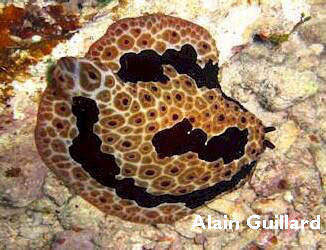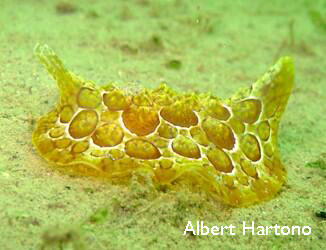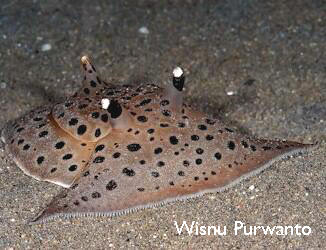Loading content - please wait...
Side Gilled Sea Slugs of the Night
Side gilled sea slugs are a delight to find during night diving in Gorontalo.
Nocturnal Sea Slugs

Nudibranchs usually have their gills exposed on the top of their bodies. But side gilled sea slugs have large plume-like gills tucked between the mantle and the foot. The gills are usually on the right side. They mostly live in shallow waters on sand and rubble bottoms. That makes the perfect location for lucky divers to find them. These slugs crawl the sea floor at night looking for tunicates
, anemones and invertibrates. They have a pair of rolled rhinophores that sense chemicals and water current. They have strong jaws and wide mouths and can even eat a sleeping fish! This type of sea slug secretes sulfuric acid when disturbed.
Grand Side Gilled Sea Slugs
The most commonly seen side gilled slug is Pleurobranchus grandis. It can grow up to 21 cm, the size of a dinner plate! Its color pattern varies. However, this slug has three red bands that contrast with its other colors. See Alain Guillard’s photo taken at Sand Bowl dive site in Gorontalo.
Forskal’s Side Gilled Sea Slugs

The beautiful Pleurobrachus forskali is named after a Finnish naturalist. Pehr Forskal was a student of Linnaeus, who recommended that King Frederick V of Denmark appoint the young Forskal to join an expedition to Arabia. While he was busy writing his book on the Flora of Egypt & Arabia, he contracted malaria. He died in 1763 in present-day Yemen. This sea slug is one of three life forms named after him.
Its color varies widely from dark plum red to peach to brown. The only consistent element of its pattern is the white semicircles that outline bumps on its mantle. Both P. grandis and P. forskali arch their mantles when moving. This forms a spout towards the rear of the slug, clearly visible in Albert Hartono’s photo of a young Forskal sea slug taken at Old Port dive site. This spout channels water and feces away from the slug as it travels.
Moon-headed Side Gilled Sea Slugs

The most unusual Euselenops luniceps is rarely seen because it buries itself in the sand during the day. Its long mantle forms a siphon that brings sea water to the slug’s gills while it is buried. Notice the siphon towards the rear of the slug in Wisnu Purwanto’s photo from Sand Bowl dive site. Mr. Purwanto shares other Gorontalo underwater photos on his Flickr page. Its most notable feature is its large, wide oral veil that covers its mouth. The veil is fringed with many sensory hairs called papillae. The slug basically feels for prey along the sand with its mouth. Moon-headed ones are the only side gilled sea slugs that can swim for some distance. To swim, it flaps the sides of its body. It only grows to 7 cm.
Although night dives are not included in dive packages that Miguel’s Diving offers, oftentimes night diving is available. Please ask when you make a booking with us.






Sorry, comments are closed for this post.